Russia Continues to Huff and Puff About Fate of Ukraine Grain Export Pact

USTR Tai travels to Japan, Philippines | Gold bugs | Brazil leader in Beijing | Retail sales
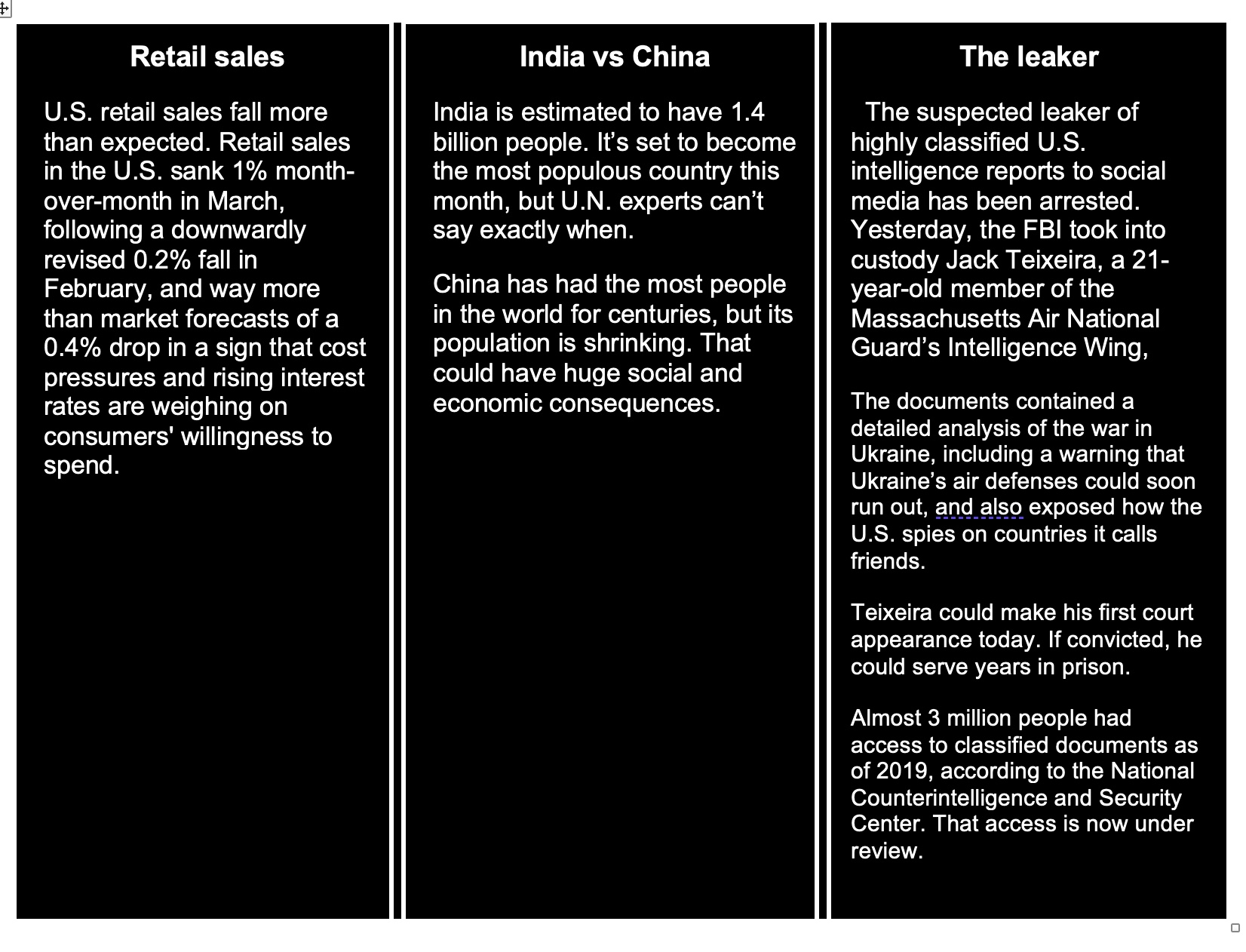
|
In Today’s Digital Newspaper |
I attended and spoke at the Virginia Cattlemen’s meeting in the southern part of the state, one of the most beautiful places in the United States. The program and trade show have attracted a lot of attention the past few years. Talks with cattle producers find them quite upbeat about recent record prices, with a few wondering if this may be near the time some will choose to exit the industry on a high note. Concerns include regulations such as WOTUS, an uncertain U.S. trade policy and the future of cell-based meat alternatives.
USDA daily export sale of 382,000 metric tons corn to China. Of the total, 246,000 metric tons is for delivery during the 2022-2023 marketing year and 136,000 metric tons is for delivery during the 2023-2024 marketing year.
Retail sales info released this morning is another data point that suggests a downturn is coming for the U.S. economy.
Atlanta Fed’s Bostic signals backing for Fed to raise and hold rates. Another 25-basis-point increase in the target range for the Fed funds rate at the May 2-3 Federal Open Market Committee (FOMC) and then a pause in rates moving forward is the expectation of Atlanta Fed President Raphael Bostic. More in Markets section.
USTR Katherine Tai is traveling to Japan and the Philippines, and she usually likes some “deliverables” on her trips abroad. More in Trade Policy section.
The Supreme Court is nearing releasing some rulings. The ag sector hopes they include decisions on WOTUS and Proposition 12.
Russia continues to huff and puff regarding the fate of the Ukraine grain export pact. More in Russia & Ukraine section.
Preliminary reports have surfaced about what House GOP leaders will present regarding budget cuts linked to the debt limit debate. House Speaker Kevin McCarthy (R-Calif.) will give an important speech on Monday. See Policy section for details.
China sets plan to trim soymeal in animal feed in bid to reduce reliance on imports. More in China section, along with an update on Brazil’s president’s trip to Beijing that starts today. Meanwhile, a USTR official signals the Biden administration is still mulling action on China over Phase 1 trade deal shortfalls.
China secretly agreed to give weapons to Russia, leaked documents show. That disputes repeated comments from Biden administration officials that there was no evidence China was providing lethal weapons to Russia.
Nearly 80% of projected income taxes for 2022 will be paid by about 10% of filers earning $200,000 or more, and those earning $1 million or more will pay half of that.
Farmers are facing more extreme crop-killing "flash droughts" as rising temperatures from climate change trigger the events more quickly.
Gold bugs are out in force. Details below.
Global crude oil demand will outstrip supply this quarter, following OPEC’s recent surprise move to cut its collective oil production, the International Energy Agency (IEA) said.
Biden Cabinet members will appear before congressional panels next week. Details in Congress section.
|
MARKET FOCUS |
Equities today: Global stock markets were mostly higher overnight. U.S. Dow opened slightly lower and then went slightly higher. Key earnings reports today include first-quarter results from JPMorgan, Citigroup and Wells Fargo. Other financial firms are also set to post earnings in the morning. In Asia, Japan +1.2%. Hong Kong +0.5%. China +0.6%. India closed. In Europe, at midday, London +0.3%. Paris +0.3%. Frankfurt +0.4%.
Some of the banks have already reported. JPMorgan reported record revenue, boosted by higher interest rates. Wells Fargo likewise benefitted from higher rates. Despite the upbeat results, which exceeded analysts’ expectations, analysts say it’s too early to say that the worst of the banking crisis is over.
U.S. equities yesterday: All three major indices finished with gains as a tepid inflation report provided support. The Dow gained 383.19 points, 1.14%, at 34,029.69. The Nasdaq rose 236.93 points, 1.99%, at 12,166.27. The S&P 500 was up 54.27 points, 1.33%, at 4,146.22.
Agriculture markets yesterday:
- Corn: May corn futures fell 3 3/4 cents to $6.52 1/4 and the nearer the session low.
- Soy complex: May soybeans led the complex lower, settling 3 1/4 cents lower at $15.01. May soybean meal notched gains of $3.40, closing at $463.60, although well off the intraday high. May soyoil fell 28 points to 53.72 cents.
- Wheat: May SRW fell 12 1/2 cents to $6.67, ending near the session low and below support at $6.73 3/4 and $6.68. May HRW fell 18 1/4 cents to $8.45 1/4, ending the session below the 20- and 100-day moving averages while May spring wheat closed 10 1/2 cents lower at $8.49 1/2.
- Cotton: May cotton rose 90 points to 83.35 cents, nearer the session high and above the 100-day moving average for the second straight session.
- Cattle: Nearby April live cattle spiked to a fresh record high for nearby cattle at $177.70 before setting back slightly to a fresh record high close, up $1.225 to $175.50. Most-active June cattle set back 35 cents to close at $164.50. May feeder futures suffered a late 77.5 cent drop to close at $207.80.
- Hogs: Expiring April lean hog futures fell 70 cents to $71.60. Most-active June futures settled at $85.65, $1.90 lower on the day.
Ag markets today: Soybeans faced pressure overnight after a poor close on Thursday, while wheat traded mostly lower, and corn was narrowly mixed. As of 7:30 a.m. ET, corn futures were trading a penny lower to 3 cents higher, soybeans were 4 to 7 cents lower and wheat futures were mostly 1 to 2 cents lower. Front-month crude oil futures were modestly firmer, while the U.S. dollar index was holding near unchanged this morning.
Market quotes of note:
- “Oil market balances were already set to tilt into a substantial deficit in the second half of this year, but the new cuts risk further tightening balances and pushing up oil prices at a time when inflationary pressures are already hurting vulnerable consumers,” the IEA said. “Consumers confronted by inflated prices for basic necessities will now have to spread their budgets even more thinly. This augurs badly for the economic recovery and growth,” it added.
- The clean energy shift is moving faster than you think, with the latest data suggesting peak fossil fuel demand is coming closer, International Energy Agency Executive Director Fatih Birol says in the Financial Times.
- “The things that we’re nervous about are all the things that we don’t have a lot of hard data about,” Karen Dynan, a Harvard economist and former Treasury official, told the New York Times. Bank earnings could be the final puzzle piece to give clarity on where the economy is heading.
- Fed’s Bostic: Fed can ‘hit the mark and hold’ with one more rate hike. One more 25-basis-point interest rate hike can allow the Federal Reserve to end its tightening cycle with some confidence inflation will steadily return to its 2% target, Atlanta Fed President Raphael Bostic said. Recent inflation data, including this week’s reports of slowing consumer price increases and falling producer price inflation, “are consistent with us moving one more time,” Bostic told Reuters. “There’s more to do. I think the next step is going to be to figure out how much more,” Bostic said. But he noted, “I think the point of ‘hit the mark and hold’ is ‘hit the mark and hold,’ unless you see a trend that is unmistakable, that is going in a way that makes you uncomfortable.”
On tap today:
• U.S. retail sales for March are expected to fall 0.5% from the prior month. (8:30 a.m. ET) UPDATE: U.S. retail sales fall more than expected. Retail sales in the U.S. sank 1% month-over-month in March, following a downwardly revised 0.2% fall in February, and way more than market forecasts of a 0.4% drop in a sign that cost pressures and rising interest rates are weighing on consumers' willingness to spend. More than 2% declines were seen in sales at gasoline stations, general merchandise stores, building materials and garden equipment, and electronics and appliances
• U.S. import prices for March are expected to fall 0.1% from the prior month. (8:30 a.m. ET) UPDATE: The price index for U.S. imports fell 0.6% from a month earlier in March 2023, the most since November 2022 and much more than market expectations of a 0.1% decrease. It follows a 0.2% decline in February. Lower prices for fuel and nonfuel imports each contributed to the March drop in U.S. import prices. Import fuel prices declined 2.9%, following a 5.7% drop the previous month, due to lower prices for both petroleum and natural gas. Prices for import fuel have not recorded a 1-month advance since June 2022. The price index for nonfuel imports decreased 0.5%, the most since July 2022, and after rising 0.9% over the previous three months. Lower prices for nonfuel industrial supplies and materials; consumer goods; foods, feeds, and beverages; capital goods; and automotive vehicles all contributed to the overall decrease in nonfuel import prices. On a yearly basis, U.S. import prices dropped 4.6%, the most since May 2020
• Federal Reserve governor Christopher Waller speaks on the economic outlook at 8:45 a.m. ET.
• U.S. industrial production for March is expected to rise 0.2% from the prior month. (9:15 a.m. ET)
• U.S. business inventories for February are expected to climb 0.3% from the prior month. (10 a.m. ET)
• University of Michigan's preliminary consumer sentiment index for April is expected to hold steady at 62, unchanged from an end-of-March reading. (10 a.m. ET)
• Baker Hughes rig count is out at 1 p.m. ET.
• CFTC Commitments of Traders report, 3:30 p.m. ET.
U.S. supplier prices fell in March by the most in nearly three years, the latest evidence that inflation is moderating. Cooling supplier prices can signal future fading of consumer inflation, if firms pass on easing costs.
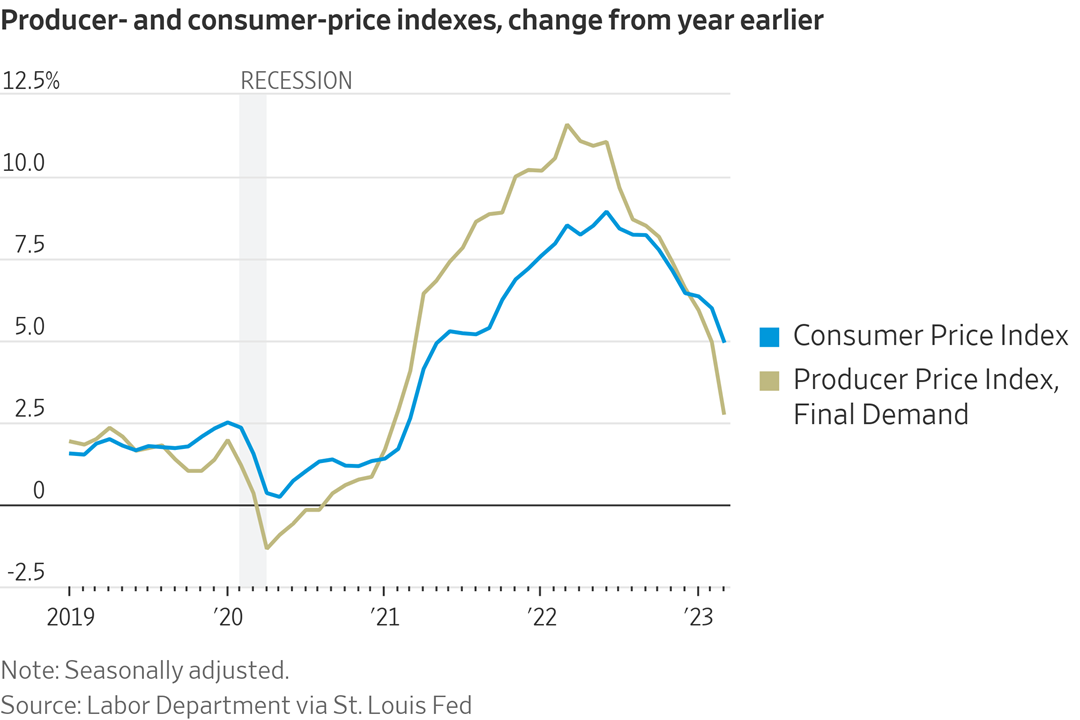
International travel bookings from the U.S. have increased more than 200% since 2022, according to AAA. Airfares for international flights have jumped more than 30%. International hotel bookings are up 300% from last year, AAA said. London is the top European destination for U.S. travelers, with a nearly 350% increase in bookings, followed by Rome, Paris, Dublin, and Barcelona. Canada is also in demand.
Big focus will be on deposits. Fed data shows that customers pulled more than $600 billion worth of deposits from their accounts in the first quarter of this year, with most of that exodus occurring in the days after the fall of SVB last month. A big chunk of that appears to be flowing into money-market funds, a move that would give individuals a solid return on their deposits, but could choke off lending and investing in the wider economy.
Who pays the most income tax? A large chunk of the income tax in the U.S. is paid by a small slice of the population. The Wall Street Journal reports (link) that nearly 80% of projected income taxes for 2022 will be paid by about 10% of filers earning $200,000 or more, and those earning $1 million or more will pay half of that.
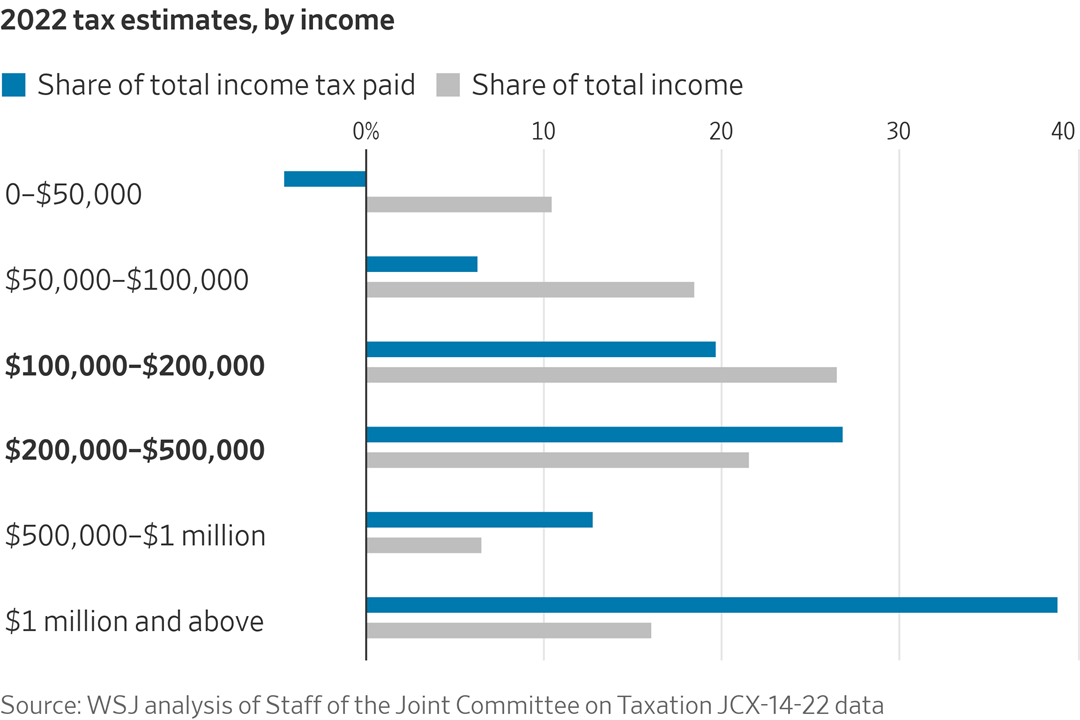
Market perspectives:
• Outside markets: The U.S. dollar index was weaker ahead of several key economic updates, with only the euro firmer against the greenback. The yield on the 10-year U.S. Treasury note was firmer, trading around 3.46% with a mostly lower tone in global government bond yields. Crude oil has moved higher, with U.S. crude around $82.35 per barrel and Brent around $86.25 per barrel. Gold and silver were weaker, with gold lower around $2,047 per troy ounce and silver higher around $26.11 per troy ounce.
• Global crude oil demand will outstrip supply this quarter, following OPEC’s recent surprise move to cut its collective oil production, the International Energy Agency (IEA) said. The oil market is expected to get tighter as rebounding demand clashes with Saudi Arabia-led production cuts. This risks sending crude prices higher and fueling more inflation just as it appears to be moderating. The IEA Friday said it expects the cuts to lead to 1.4 million barrels a day less of oil between March and the end of the year. The planned cuts are expected to begin next month and last until the end of the year.
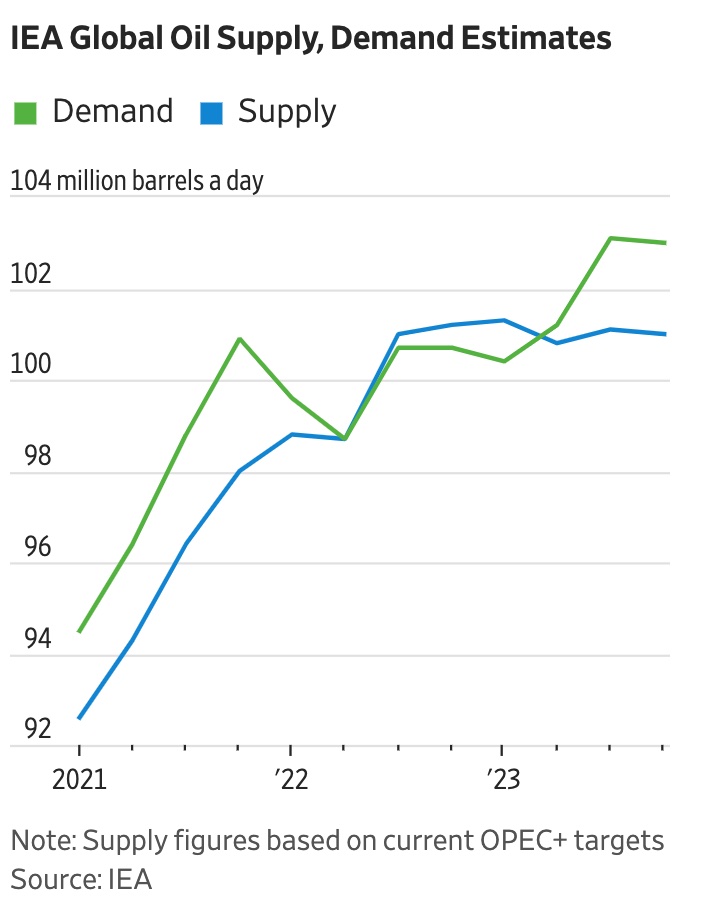
Meanwhile, oil is headed for a fourth straight week of gains.
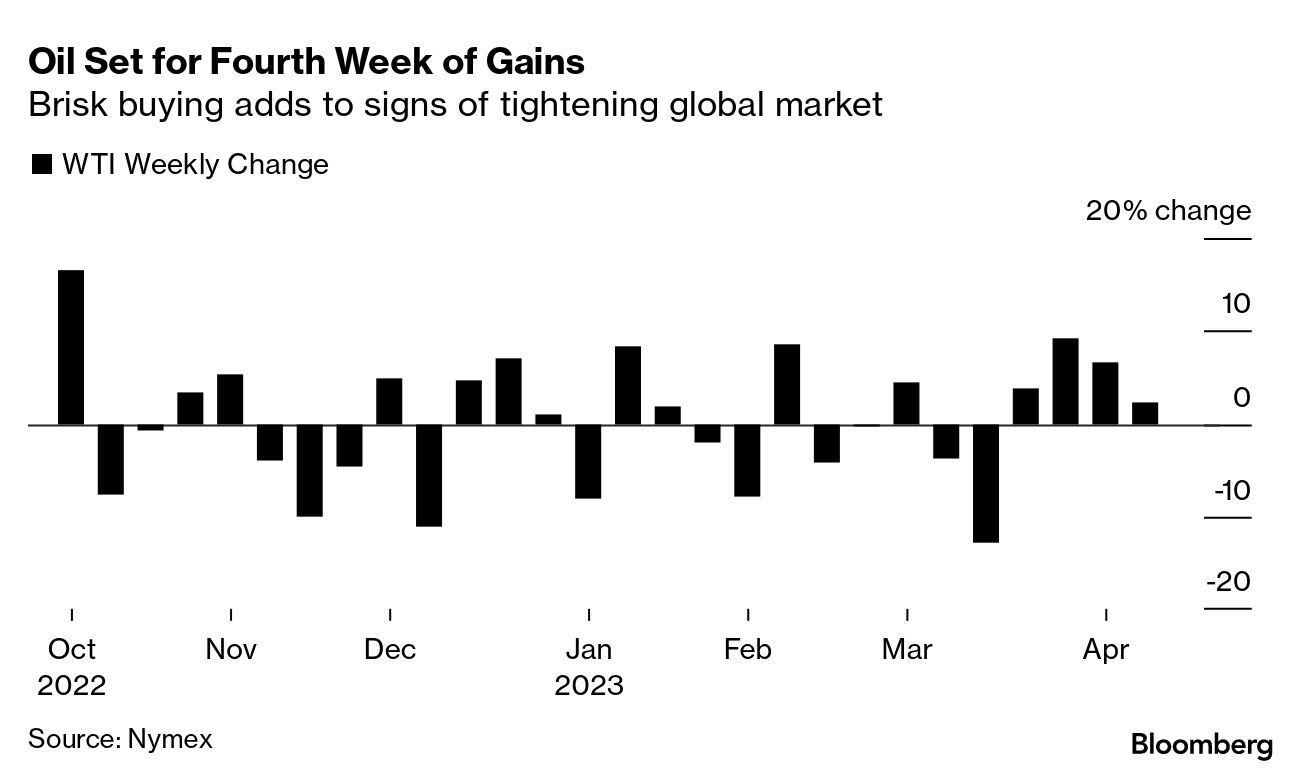
• Gold prices hit their highest level of the year on Thursday, with the most actively traded gold-futures contract coming close to its record high. This rally was driven by bets that inflation will remain sticky despite recent declines. Details: The most actively traded gold-futures contract rose to $2,055.30 a troy ounce, up 13% year to date. That also put it within striking distance of its record high, reached in the summer of 2020.
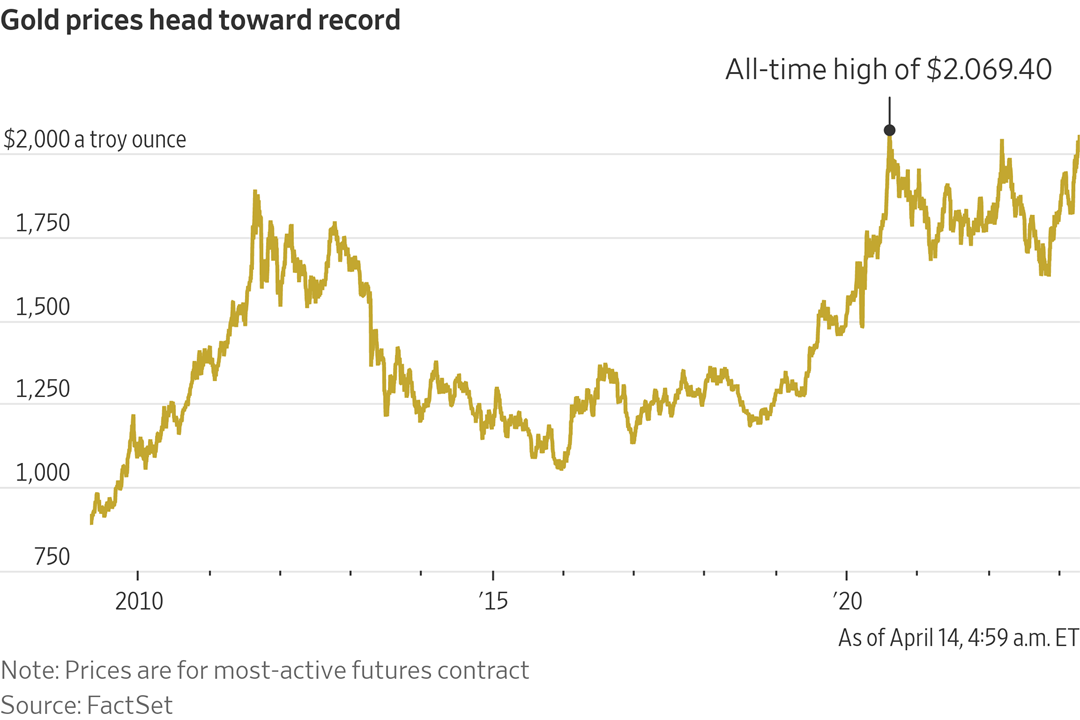
• Ag trade: South Korea purchased 68,000 MT of corn expected to be sourced from South America. Thailand purchased 55,000 MT of Black Sea origin feed wheat. The Philippines is seeking 330,000 MT of rice to boost state-owned emergency reserves.
• Farmers are facing more extreme crop-killing "flash droughts" as rising temperatures from climate change trigger the events more quickly, causing the water to evaporate from plants and soil during the growing seasons, according to research published in the journal Science. Link for details.
• A once-in-1,000-years rainstorm poured down on Ft. Lauderdale, Florida, on Wednesday, drenching the city with 20–25 inches of rain—equivalent to more than a third of its typical annual rainfall, the Washington Post reported. Fort Lauderdale-Hollywood Airport was shut down and is scheduled to reopen this morning.
• NWS weather outlook: There is a Slight Risk of severe thunderstorms over parts of the Central Plains and an Enhanced Risk of severe thunderstorms over parts of the Lower Mississippi Valley on Saturday... ...Snow over the Northern/Central Rockies and light snow over parts of the Upper Mississippi Valley on Saturday... ...Temperatures will be 15 to 25 degrees above average over parts of the Upper Mississippi Valley, Great Lakes, and Northeast.

Items in Pro Farmer's First Thing Today include:
• Mostly weaker grain market tone overnight
• Brazil soybean cargo headed to Southeast United States
• Russia sharply increases wheat export tax
• April live cattle chasing cash
• Cash hog index marks new low for the year
|
RUSSIA/UKRAINE |
— China secretly agreed to give weapons to Russia, leaked documents show. China planned to disguise the military equipment as civilian items, according to a U.S. intercept of Russian intelligence. This was revealed in the classified files leaked on Discord. China says it is neutral on the war in Ukraine and has positioned itself as a potential peacemaker. But the leak suggests its ties with Russia are deepening. Also, Biden administration officials repeatedly said there was no evidence that China was giving or was planning on providing lethal weapons to Russia.
— Russia: West still has time to solve issues with grain deal. The West still has time to remove “obstacles” hindering the implementation of the Black Sea grain deal before a deadline on May 18, senior Russian diplomat Mikhail Ulyanov said on Friday. Russia has been increasing its rhetoric that the grain deal won’t be extended unless its demands are met, including removing what it says are obstacles to grain and fertilizer exports, along with state bank Rosselkhzbank being reinstated in the SWIFT global financial communications system.
|
POLICY UPDATE |
— GOP, McCarthy planning one-year deal on debt limit. House Speaker Kevin McCarthy (R-Calif.) is developing a plan to suspend the federal government’s debt ceiling for a year in exchange for spending cuts, according to reports. The plan will be disclosed when Congress reconvenes next week and proposes a House vote next month to suspend the ceiling until May 2024.
Details: Republican leaders are weighing whether to cap nonmilitary discretionary spending, or overall discretionary spending, at fiscal 2022 levels. McCarthy’s proposal would keep nonmilitary discretionary spending at fiscal 2022 levels, but allow for a 1% annual increase over 10 years, Bloomberg reported (link). It would take back unspent Covid-19 relief money, prohibit Biden’s student loan forgiveness program, require Medicaid recipients aged 60 and under without dependent children to work, repeal some green tax credits, and implement the House Republican energy plan, Punchbowl News reported.
Warning: Sources say some items on the GOP list are options, and nothing official has been decided. The goal is to coalesce around legislative text soon with a vote by the end of May.
Of note: McCarthy is scheduled to speak Monday morning at the New York Stock Exchange, when he is expected to talk about the debt ceiling and Congress’ determination not to raise it without spending cuts.
— WOTUS rule. On Tuesday, lawmakers will debate whether to override President Joe Biden’s veto of a resolution invoking the Congressional Review Act to block the Biden administration’s rule defining waters subject to environmental regulation, the Waters of the U.S. (WOTUS). The Environmental Protection Agency and the Army Corps of Engineers published the latest WOTUS rule on Jan. 18 and it went into effect on March 20. Court actions have halted implementation in 26 states. There is a pending ruling on the matter coming from the Supreme Court.
|
PERSONNEL |
— Labor Dept. nominee to get Senate panel review. Julie Su, Biden’s pick to lead the Labor Department, will go before the Senate Health, Education, Labor and Pensions Committee on Thursday. Republicans on the panel said yesterday they haven’t been able to set up a meeting with her before she’s due to appear before the panel.
|
CHINA UPDATE |
— USTR official signals administration mulling action on China over Phase 1 trade deal shortfalls. The Phase 1 trade agreement negotiated between the two countries under the Trump administration allowed for penalties to be assessed for failure to live up to commitments in the trade deal. The Biden administration is still considering actions to take against the People’s Republic of China (PRC) for failing to meet purchase commitments and other terms of the deal, Deputy U.S. Trade Representative Sarah Bianchi said in Washington Thursday. The administration “will continue to press the PRC on its state-centered and non-market trade practices, and to live up to its commitments through the Phase 1 agreement.”
China has not met “a number of commitments” in the Phase 1 trade deal, Bianchi said. “Certainly the purchase agreements, but other provisions as well.”
The Biden administration previously launched a comprehensive four-year review process of the Section 301 tariffs on imports, she noted, and said they are taking a “deliberate and strategic look at how we can serve our interests in light of the PRC’s continued unfair policies and practices.”
— China to trim soymeal in animal feed in bid to reduce reliance on imports. China’s Ministry of Agriculture and Rural Affairs released a new plan to reduce the level of soybean meal in animal feed over three years, seeking to trim feed ratios to under 13% by 2025, down from 14.5% in 2022. The new target of under 13% by 2025 is slightly lower than an earlier target of 13.5%, but the direction is not new, said Lief Chiang, senior analyst at Rabobank.
The new plan would "guide the feed industry to reduce the amount of soybean meal, promote the saving and consumption reduction of feed grains, and contribute to ensuring the stable and safe supply of grain and important agricultural products,” according to a Reuters report recapping the ministry document.
Impacts: Some believe the action could reduce China’s soybean imports as it could reduce soymeal usage by up to 3 million tonnes per year. But U.S. Soybean Export Council chief Jim Sutter said he was not concerned about a significant decline in imports. "I think we'll see strong demand continuing. There's a limit as to how much soy can be taken out of rations," Sutter said. A decline in soybean imports would boost China’s imports of rapeseed and sunflowerseed along with synthetic proteins as soymeal substitutes. A decline in soybean imports to crush for soybean meal would also reduce soybean oil production, potentially upping the country’s needs for imports of palm oil and other vegetable oils.
— China starts review of tariffs on Aussie barley. China’s commerce ministry said on Friday it will review the necessity of continuing to impose anti-dumping and anti-subsidy tariffs on imported Australia barley from April 15, with the survey to be completed within a year. The statement follows an agreement reached between China and Australia earlier this week to resolve their dispute over barley imports. Australian Foreign Minister Penny Wong said China had agreed to carry out an “expedited review” of the duties over three or four months.
— Brazilian President Luiz Inácio Lula da Silva is due to meet Chinese leader Xi Jinping in Beijing in a state visit beginning Friday. The Wall Street Journal reports (link) that more goods movement between the countries is on the agenda, with some 20 bilateral deals to be signed during the trip. China overtook the U.S. in 2009 as Brazil’s biggest trading partner, as the Latin American nation became the go-to supplier to feed the Asian nation’s rapidly growing population and factories.
Brazilian exports to China totaled some $89.7 billion last year, and more than half of it was in soybeans and iron ore, making the trade a linchpin of the dry-bulk shipping sector. The countries have also explored deals in other industries such as healthcare and technology, which could boost trade beyond commodity flows.
Meanwhile, Brazil's currency hit its strongest level against the U.S. dollar in 10 months, undercutting the value of the country's exports.
|
TRADE POLICY |
— Japan, Philippines visit by USTR Tai to promote U.S. Indo-Pacific trade plan. U.S. Trade Representative (USTR) Katherine Tai will meet with leaders in the Philippines and Japan next week, as the Biden administration works to prove that its year-old trade framework is yielding results. The next negotiating round will take place in Singapore in May.
Upshot: Tai likes “deliverables” and some ag-sector announcements are possible, contacts advise. Recall that President Ferdinand Marcos Jr. agreed to extend the country’s reduced tariff rates on pork for another year — through the end of 2023. Another extension is possible.
|
ENERGY & CLIMATE CHANGE |
— Energy Department approved liquefied natural gas exports from the $39 billion Alaska LNG project owned by Alaska Gasline Development Corp., which is expected to come online by 2030 pending additional required permits. The exports will be shipped mainly to countries in Asia, as the United States competes with Russia to send natural gas supplies to Asia from the Arctic.
|
HEALTH UPDATE |
— White House wants to open U.S. health-care plans to DACA immigrants. DACA immigrants are those who were brought to the U.S. as children and don’t have permanent legal status. There are about 580,000 people in the DACA program. The plan, announced yesterday, would give DACA recipients access to health insurance through Medicaid and the Affordable Care Act.
— The origin of Covid-19 is the subject of a Tuesday hearing in the House Select Subcommittee on the Coronavirus Pandemic, where former Director of National Intelligence John Ratcliffe will testify.
— Infectious disease experts brace for the next Covid-like pandemic. Superspreader viruses like Covid-19 are emerging more rapidly in an era of global travel and climate change. Airfinity, a predictive disease specialist, forecasts that the odds of such a pandemic striking in the next decade are greater than one in four.
|
POLITICS & ELECTIONS |
— Republican presidential hopefuls, including former President Donald Trump, Gov. Ron DeSantis of Florida, and Nikki Haley, a former ambassador to the United Nations, are expected to address the annual gathering of the National Rifle Association today.
|
CONGRESS |
— House Homeland Security Secretary Alejandro Mayorkas returns to Capitol Hill next week for hearings. Mayorkas will defend his department’s fiscal 2024 appropriations request before the Senate Homeland Security Committee on Tuesday and the House equivalent on Wednesday. Lawmakers on both panels are expected to grill Mayorkas on new border policies and how the administration plans to manage the end of pandemic-related restrictions in May.
Other cabinet secretaries scheduled to testify include:
- Commerce’s Gina Raimondo at House Appropriations Tuesday.
- Education’s Miguel Cardona at House Appropriations Tuesday.
- Housing and Urban Development’s Marcia Fudge at House Appropriations Tuesday.
- Transportation’s Pete Buttigieg at House Appropriations Thursday.
— IRS Commissioner Daniel Werfel will testify Wednesday at a Senate Finance Committee hearing, one day after the federal tax filing deadline, and as Republicans scrutinize the agency’s plan to spend an $80 billion infusion it plans for scrutinizing wealthy taxpayers.
|
OTHER ITEMS OF NOTE |
— Cotton AWP moves back above 70 cents. The Adjusted World Price (AWP) for cotton moved up to 70.05 cents per pound, effective today (April 14), up from 69.88 cents per pound the prior week. The AWP had been below 70 cents per pound for four straight weeks.
— Twitter users will soon be able to trade stocks and crypto in the app as part of a deal with social investing company eToro. It’s a step toward the company becoming an “everything app,” a stated goal from owner Elon Musk.
|
KEY LINKS |
WASDE | Crop Production | USDA weekly reports | Crop Progress | Food prices | Farm income | Export Sales weekly | ERP dashboard | California phase-out of gas-powered vehicles | RFS | IRA: Biofuels | IRA: Ag | Student loan forgiveness | Russia/Ukraine war, lessons learned | Russia/Ukraine war timeline | Election predictions: Split-ticket | Congress to-do list | SCOTUS on WOTUS | SCOTUS on Prop 12 | New farm bill primer | China outlook | Omnibus spending package | Gov’t payments to farmers by program | Farmer working capital | USDA ag outlook forum |






